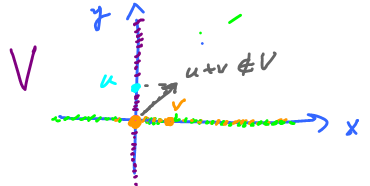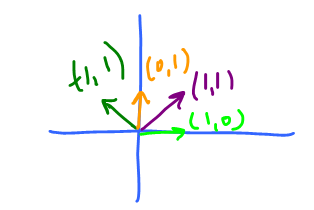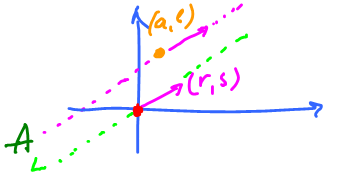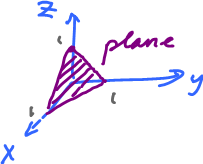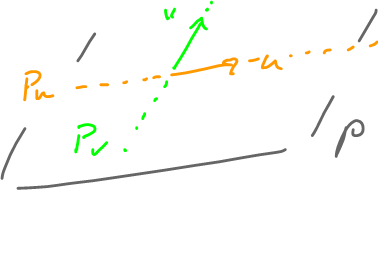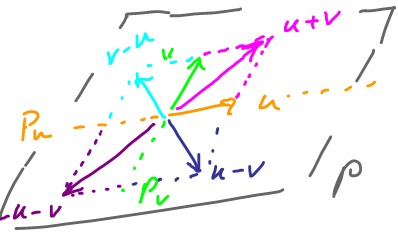This site is being phased out.
More on vector spaces
Besides Euclidean spacees, another important class of examples of vector spaces is...
Contents
Function spaces
Observation: There are algebraic operations on functions $f \colon {\bf R} \rightarrow {\bf R}$:
- addition,
- subtraction,
- multiplication,
- division.
But we will ignore the last two, for now.
Let $V$ be the set of all functions $f \colon {\bf R} \rightarrow {\bf R}$.
Note: The difference in the meaning of this notation is that, in Calc 1, this means that domain $f \subset {\bf R}$ and here domain $f={\bf R}$.
Let's define operations on $V$.
Keep in mind the notation:
- $f$ represents the function as a whole, and
- $f(x)$ represents its value at $x$.
Let's define addition on $V$.
Given $f,g \in V$, what is $h=f+g \in V$?
Note: we know how to add numbers but not functions yet!
How?
We simply need to know $h(x)$ for each $x$. Here it is:
- $h(x)=f(x)+g(x)$ for each $x \in {\bf R}$.
Define scalar multiplication on $V$ now.
We need to know, given $f \in V$, $r \in {\bf R}$, what is $h=rf$? Here:
- $h(x)=rf(x)$ for each $x \in {\bf R}$.
Exercise: Verify the axioms. (How? Entry-wise, input-wise: for each $x$, $f(x) \in {\bf R}$. ${\bf R}$ is a vector space! Use it.)
What about other vector spaces of functions?
How about we narrow it down. We suppose $f$ is continuous. Then we have same operations.
But, we have to ask: is the set closed under these operations?
Recall from Calculus 1: course.
Theorem: The sum of two continuous functions is continuous.
Theorem: The product of a number and a continuous function is continuous.
Where do these come from? From theorems about limits: sum rule and constant multiple rule.
So, $C({\bf R})$ is closed under these operations.
How about $C^1({\bf R})$, differentiable functions (or integrable, etc). Make your own examples.
Example: Let $V = \{ f \in C({\bf R}) \colon f(0)=0 \}$ .
Is it closed under the operations above?
Given $f,g \in V$. Then
- #1. $(f+g)(0) = f(0)+g(0) = 0+0 = 0$, so $f+g \in V$.
- #2. $(cf)(0) = cf(0) = c \cdot 0 = 0$, so $cf \in V$.
Yes!
Subspaces
We need closedness to have a vector space, but is closedness sufficient?
Not in general, you need the axioms too.
But what about specifically subsets of vector spaces?
Look at ${\bf R}^2$. What are possible vector spaces that exists as subsets of ${\bf R}^2$?
One answer is: all straight lines through $0$.
Let $V = \{ (x,y) \in {\bf R}^2 \colon y=mx\}$.
For closedness consider:
- $(x,y), (a,b) \in V \rightarrow y=mx, b=ma$, then $(x,y)+(a,b) = (x+a,y+b)$.
Do they satisfy the equation?
- $y+b=m(x+a)$,
yes!
Same for scalar multiplication.
But what about the axioms?
Geometrically, they are satisfied clearly. Just, compare $V$ and ${\bf R}$:
You have to look at the magnitudes only.
The operations look very similar! This suggests that $V$ satisfies the axioms, just as ${\bf R}$ does.
Theorem: Given a vector space $U$, and a subset $V$ of $U$. Also assume:
- 1. $0 \in V$,
- 2. $V$ is closed under addition of $U$,
- 3. $V$ is closed under scalar multiplication of $U$.
Then $V$ is a vector space.
Proof: 2. and 3. mean the operations make sense on $V$.
Recall the definition of vector space. The axioms:
- 1. $u+v=v+u$
- 2. $(u+v)+w = u+(v+w)$
- 3. There is a vector $0 \in V$ such that $0+a=a$ for all $a \in V$.
- 4. For each $a \in V$, there is a vector $-a \in V$ such that $a + (-a)=0$.
- 5. $r(u+v)=ru+rv$
- 6. $(r+s)u = ru+su$
- 7. $(rs)u = r(su)$
Let's check them each.
- #1. Given $u,v \in V$, then $u,v \in U$, so since $U$ is a vector space, it satisfies #1. So $u+v=v+u$, within $U$ by condition 2 (note $u$ and $v$ are in $V$). But also within $V$... we never leave $V$.
- #2. Same argument.
- #3. Let the identity of $V$ be $0$ (the identity of $U$); it's ok by condition 1.
$0+a=a$ for all $a \in U$, since $U$ is a vector space. Hence $0+a=a$ for all $a \in V$, since $V \subset U$.
- #4. Given $a \in V$, we need to define an element $-a \in V$ such that $a + (-a) = 0$. Choose as $-a$, the inverse of $a$ in $U$. It's ok because $-a \in V$. Why? Use one of the properties: $-a=(-1)a$, scalar multiplication. So by condition 3, $(-1)a \in V$.
- #5-8. Proven by using conditions 2 and 3.
$\blacksquare$
Can we drop some of the conditions of the theorem? Will it still hold?
Let's try.
What if $0 \not \in V$?
Consider $V = \{(x,y) \colon y = x+1 \} \subset {\bf R}^2$ here $0 \not\in V$. This is not a vector space!
What if it's not closed under addition?
Let's try build it. Start, for example, with $v=(1,0)$. (Note: Such a vector exists because $\{0\}$ is a vector space, so there is at least one non-zero vector in $V$, $v$.)
Condition 3 is satisfied, so $2v, 3v, -v, \ldots \in V$, so the whole $x$-axis $\subset V$. But the $x$-axis is a vector space!
So, there should be a vector in $V \setminus \{x$-axis$\}$, $u$.
Condition 3 is satisfied, so the $y$-axis $\subset V$. Observe $u+v \not\in V$.
So, $V$ is not a vector space!
But it does satisfy 3. Hence we can't drop 2.
Note: the construction ends with $V = \{ (x,y) \colon x=0 {\rm \hspace{3pt} or \hspace{3pt}} y=0 \}$.
Exercise: Show that condition 2 can't be dropped.
Notation:
- ${\bf Z} = \{0, \pm 1, \pm 2, \ldots\}$;
- ${\bf Q} = \{ \frac{p}{q} \colon p, q \in {\bf Z}, q \neq 0 \}$
Quiz: Prove or disprove: ${\bf Q}$ is closed under addition.
Proof: Suppose $u,v \in {\bf Q}$, then $u=\frac{p}{q}$, $v = \frac{r}{s}$ for some $p,q,r,s \in {Z}$. Then $u+v = \frac{p}{q} + \frac{r}{s} = \frac{ps+rq}{qs}$. And here $ps+rq, qs \in {\bf Z}$. Hence $u+v \in {\bf Q}$.
Question: Is ${\bf Q}$ closed under scalar multiplication?
Answer: No, $\sqrt{2} \cdot 1 = \sqrt{2} \not\in {\bf Q}$.
Definition: A subset of a vector space that is also a vector space under its operations is called a subspace.
Issue: Subsets vs subspaces, sets vs vector spaces, i.e., they have extra structure (algebraic operations).
Big question: Suppose $V \subset W$, subset of a vector space. Is it a subspace, i.e., do 1-3 hold?
Restate the above theorem.
Subspace Theorem: A subset $V$ of a vector space $W$ is a subspace if $V$ contains $0$ and is closed under the algebraic operations of $W$.
This is a powerful tool to discover new vector spaces.
${\bf R}^2$, subspaces:
- all lines through $0$ (prove).
${\bf R}^3$, subspaces:
- 1. all lines through $0$,
- 2. all planes through $0$.
Point: To prove, no need to prove the axioms.
Other examples from recently:
- $F$ is the vector space of functions, then $C({\bf R})$, continuous ones, is a subspace.
- $C^1({\bf R})$ (differentiable) is as well.
All we need to show:
- 1. The sum of two continuous functions is continuous.
- 2. A constant multiple of a continuous function is continuous.
But we already know it from Calculus 1!
New example: all polynomials = ${\bf P}$ (exercise).
Consider $$P \subset C^1({\bf R}) \subset C({\bf R}) \subset F$$ They are subsets.
But they are subspaces too. In fact, these are "proper" subspaces: $A \subsetneq B$.
Example: In ${\bf M}(2,2)$, choose diagonal matrices, like: $A = \left[ \begin{array}{ccc} a & 0 \\ 0 & b \end{array} \right]$. Call it $D$. Is $D$ a subspace?
First, $\left[ \begin{array}{ccc} a & 0 \\ 0 & b \end{array} \right] + \left[ \begin{array}{ccc} c & 0 \\ 0 & d \end{array} \right] = \left[ \begin{array}{ccc} a+c & 0 \\ 0 & b+d \end{array} \right] \in D$.
Second, $r\left[ \begin{array}{ccc} a & 0 \\ 0 & b \end{array} \right] = \left[ \begin{array}{ccc} ra & 0 \\ 0 & rb \end{array} \right] \in D$. Yes!
Exercise: Prove or disprove that the intersection of two subspaces is a subspace.
Question: Is the union of two subspaces always a subspace?
Answer: No.
Counterexample:
- $U = \{x$-axis$\}$ and
- $V = \{y$-axis$\}$
are subspaces of ${\bf R}^2$.
Consider, $U \cap V = \{0\}$ is a subspace, but $U \cup V$ is not a subspace, since $(1,0) \in U$ and $(0,1) \in V$ but $(1,0)+(0,1)=(1,1) \not\in U \cup V$.
Question: What about subspaces in ${\bf R}$? There is no example. Subspaces of ${\bf R}$ are $\{0\}$ and ${\bf R}$ itself, and only these two!
(Note: The irrationals is not a subspace: $\sqrt{2}\sqrt{2} = 2$ and $\sqrt{2} - \sqrt{2}=0$.)
A rich source of examples of subspaces in the Euclidean space is...
Lines
Some of these are subspaces of ${\bf R}^2$ and ${\bf R}^3$. This is what we know:
Theorem: A straight line in ${\bf R}^2$ is a subspace if and only if it contains $0$.
Proof: We did ($\Leftarrow$) earlier. Next, to do ($\Rightarrow$) we observe that the definition requires that a vector space contains $0$. $\blacksquare$
Let's be careful here. We know lines as $y=mx+a$, with $m$ the slope. They pass through $0$ if $a=0$. However, this representation omits vertical lines! We need to resole this before we generalize the idea to abstract vector spaces.
Suppose $V$ is a vectors space, what is a line in a vector space?
To get the idea, go back to Calculus 2 and Calculus 3, specifically parametric curves.
A straight line is a parametric curve:
$\left\{ \begin{array}{rl} x=t \\ y=mt \end{array} \right\}$,
but once again no vertical lines here?
Better:
$\left\{ \begin{array}{rl} x=rt \\ y=st \end{array} \right\}$,
Here $r,s \in {\bf R}$ are fixed, and we assume that not both are $0$. Note: $t \in {\bf R}$ parameter (you can think of $t$ as time).
Then we can rewrite $$(x,y) = (rt,st)$$ as vectors.
What is the meaning of $r$ and $s$?
They determine the direction (the angle) of the line. In fact, $(r,s)$ is a vector and it's called the direction the vector of the line.
So the line is, $$(x,y)=t(r,s)$$ (here $t$ is a variable, and $(r,s)$ is fixed).
Observe that vector $(x,y)$ is always proportional to $(r,s)$, therefore they have the same direction.
Definition: Given a vector space $V$ and a non-zero vector $v$. Then the set
$$L=\{tv \colon t \in {\bf R}\}$$
(all multiples of $v$) is called the line in the direction of $v$.
Theorem: For $v \neq 0$, a line $L$ in the direction of $v$ is a subspace.
Proof: Let $u,w \in L$. Then $u=tv$, for some $t \in {\bf R}$, and $w = sv$, for some $s \in {\bf R}$. Then $u+w=tv+sv=(t+s)v \in L$, since $t+s \in {\bf R}$. So $L$ is closed under addition. Scalar multiplication -- exercise. $\blacksquare$
Also, given $w \in V$, $A = \{u = w + tv \colon t \in {\bf R}\}$ is called the line through $w$ in the direction of $v \neq 0$.
Recall, every line in ${\bf R}^2$ is given by $$(x,y) = (a,b)+t(r,s).$$ The idea comes from the motion interpretation: $(a,b)$ is the initial location and $(r,s)$ is the direction of the motion.
We already know this
Fact: $A$ is a subspace if $(a,b)=0$.
Exercise: What about "only if"?
- $A$ is also called an affine subspace.
- $L$ is also called a linear subspace.
Another example, in space, is...
Planes
We start in ${\bf R}^3$.
We already know that $x+y+z=1$ is not a subspace.
Instead consider $x+y+z=0$, then this is a subspace: $$P = \{(x,y,z) \in {\bf R}^3 \colon x+y+z=0\}.$$
In general, $$P \colon Ax + By + Cz =0,$$ gives all planes through $0$, provided not all $A,B,C = 0$.
Theorem: $P$ given above is a subspace.
Proof: Exercise.
This is coordinate dependent though.
Just like with lines, let's find a parametric representation. This is called parametric surfaces. Compare these two.
- Multiples of $v$, $L = \{ \alpha v \colon \alpha \in {\bf R} \}$:
- Combinations of $u$ and $v$, $P = \{\alpha u + \beta v \colon \alpha, \beta \in {\bf R} \}$):
Definition: Given two vectors $u,v$ that are not multiples of each other, then define $$P = \{ \alpha u + \beta v \colon \alpha, \beta \in {\bf R}\}$$ as the plane in the direction of $u,v$.
Consider these subsets
- $P_u = \{ \alpha u \colon \alpha \in {\bf R} \}$, a line in the direction of $u$ and
- $P_v = \{ \beta v \colon \beta \in {\bf R} \}$, a line in the direction of $v$.
What if $u = \lambda v$?
Then $P$ is a line: $$\alpha u + \beta v = \alpha \lambda v + \beta v = (\alpha \lambda + \beta) v.$$ Since $\alpha \lambda + \beta \in {\bf R}$ we get all multiples of $v$.
So, in this case, $P$ is the line in the direction of $v$.
In general, start with the two lines...
A lot more here than that. Indeed, we add more and more vectors to fill in the plane:
Theorem: $P$ above is a subspace of ${\bf R}^3$.
Definition: $$P = \{(x,y,z) = w+\alpha u + \beta v, \alpha, \beta \in {\bf R} \}$$ is called the plane through $w$ in the direction of $u,v$, where $w,u,v \in V$, a vector space.
Example: Consider $$V = {\bf C}({\bf R}), w=3, u = x,v=x^{2}.$$
Then the elements of $P$ are: $$q = w+\alpha u + \beta V= 3 + \alpha x + \beta x^2,$$ with $\alpha, \beta \in {\bf R}.$ (Note: $x \in {\bf R}$ is a variable here.)
What is $V$, as a set?
It is the set of all quadratic polynomials with free term $=3$.
Quiz: Let $V$ be space of all polynomials and $S = \{ p \in V \colon p(\sqrt(2))=0 \}$. Prove $S$ is a vector space.
By the theorem, verify 3 conditions
- 1. $S \neq 0$. Choose the zero polynomial.
- 2. Closed under addition, $p,q \in S$ implies $p(\sqrt{2})=0$ and $q(\sqrt{2})=0$, so $p+q \in S$ (note: instead of $p(x), q(x)$!).
Consider $(p+q)(\sqrt{2}) = p(\sqrt{2})+q(\sqrt{2}) = 0+0 = 0$, so $p+q \in S$.
- 3. Closed under scalar multiplication: $p \in S$, $r \in {\bf R}$ implies $p(\sqrt{2})=0$ and so $rp \in S$.
Consider $(rp)(\sqrt{2}) = rp(\sqrt{2}) = r \cdot 0 = 0$, so $rp \in S$.
Homework:
Let $V$ be the vector space of all polynomials and $T = \{ p \in V \colon p(\sqrt{2}) = 0$ and $p(\pi) = 0 \}$. Prove that $T$ is a vector space.


